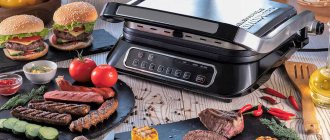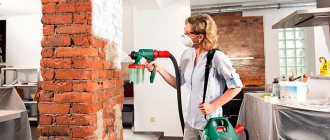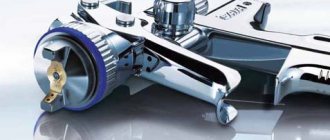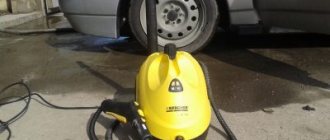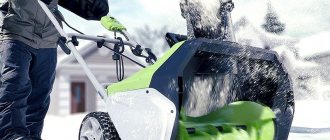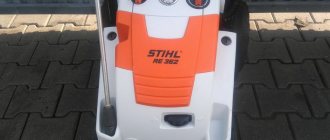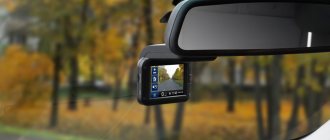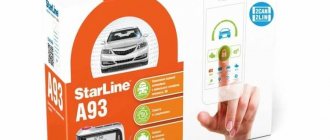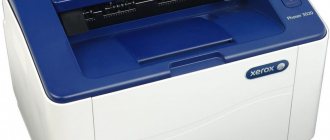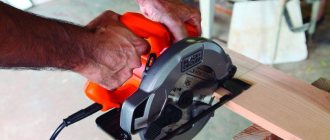| Place | Name | Characteristics in the rating |
| The best budget electric spray guns with a built-in pump |
| 1 | Bison KPE-350 | Best power indicator |
| 2 | Patriot SG 110 | Lowest price in the segment |
| 3 | Bort BFP-280 | Optimal balance of characteristics |
| 4 | Hammer PRZ110 | Optimal combination of price and quality |
| The best professional electric spray guns |
| 1 | Caliber ABR-850 | Better performance |
| 2 | ASPRO-1800 | High engine power. Optimal configuration |
| 3 | WAGNER ProjectPro119 | Best device quality |
| 4 | WAGNER Control Pro 350 M Airless | High level of reliability |
| The best electric spray guns with a remote pump |
| 1 | BOSCH PFS 5000 E | The most powerful model (1200 W) |
| 2 | BISON KPE-750 | Wide range of feed control for processed material (up to 0.8 l/min) |
| 3 | BLACK+DECKER HVLP400 | Large volume of liquid reservoir (1.2 l). Longest spray hose (6 m) |
| The best pneumatic spray guns |
| 1 | SATA 100BP | High quality tool |
| 2 | Wester FPG-30 | The best price for a quality spray gun |
| 3 | Patriot LV 500 | Excellent value for money and quality |
The best budget electric spray guns with a built-in pump
The peculiarity of this painting equipment is its efficiency in terms of energy consumption, compact overall dimensions and high mobility, limited by the length of the power cable. As for the disadvantages, they are distinguished from higher-ranking models by the low power of the built-in motor (on average 110 W), low performance, and the lack of additional functionality. It should be understood that the scope of applicability of spray guns with a built-in compressor is somewhat different, and therefore you should not expect much from them in terms of performance indicators.
Types of spray guns for water-based paint
Currently, there are 3 types of spray guns that can cope with spraying water-based emulsion: mechanical, pneumatic and electric. The first 2 types of tools have only an air type of spraying, while electrical devices can operate on an airless principle, pushing paint out of a nozzle under pump pressure. If you choose the ideal paint sprayer for water-based paint, then you should give preference to the second type, since this mixture, when sprayed by air, tends to dry even as it approaches the surface. This disadvantage mainly occurs when using high pressure pneumatic systems and only with low dilution with water, but can cause some inconvenience. Understanding the basic nuances of working with the tool and the paint mixture, you can apply a high-quality, even layer of water-based emulsion using any type of sprayer. Read on to learn about the main features, advantages and disadvantages of the above types of spray guns.
Mechanical (manual) spray gun for water-based paint
The simplest and most reliable device for spraying liquid of a sufficient degree of viscosity (up to 30 din - fatty kefir). It is a hand pump with 2 hoses, one of which is lowered into a container with the composition, and the other spits out this mixture under pressure from the nozzle. A hand-held spray gun for water-based paint has an extension (rod) that allows spraying at a distance of up to 3 meters from the operator, which significantly increases the convenience of whitewashing ceilings.
A mechanical spray gun is mobile and autonomous, but requires constant pumping and the help of a partner who will do it. The quality of liquid atomization is acceptable, but in relation to other types of devices it is the lowest. Uneven pressure at the nozzle outlet, associated with the constant need for pumping, is reflected in the final paint layer, where large droplets may alternate with small ones. In general, with the proper skill of the team of painter and assistant, you can get a very decent result and cover up to 250 m²/hour.
Electric spray gun for water based paint
A very effective tool, optimal for household and amateur use. An electric spray gun for water-based paint can be air-operated, with a portable mini-compressor, or airless, where the paint flies out of the nozzle under pump pressure. The price of budget models of electric spray guns starts from 2000 rubles, which is very cheaper compared to mechanical ones, which cost from 4500. More professional devices have completely different prices, reaching tens and even hundreds of thousands of rubles. The most suitable type of spray gun for working with water-based paint is a special airless painting installation with the ability to install a fishing rod and a gun with a vertical direction. Such devices are a small installation that pumps out a mixture from a container and supplies it through a hose to a sprayer. Such devices are equivalent to more professional ones and their cost starts from 20 thousand rubles.
Budget models of spray guns cannot be equipped with an extension or a vertical guide, but they cope with the task of spraying paint effectively. A similar spray gun can be used for water-based acrylic paint, water-based emulsion and other mixtures of a decent degree of viscosity. The applied layer is uniform, and unlike the mechanical analogue, the work does not require an assistant, but only a connection to the network. There are also battery-powered models, but they are much more expensive and less common. The average coating speed of an electric spray gun is 200-300 m²/hour.
Pneumatic spray gun for water based paint
A tool for professional and amateur use, aimed at working with paints and varnishes based on esters and natural resins. Pneumatic sprayers can handle water emulsion, but purchasing such systems just for whitewashing is not practical. A pneumatic spray gun operates using compressed air supplied from a compressor through a special sealed hose. With this tool, you can get a very uniform, high-quality level of painting, but for this you need to fine-tune it by adjusting the pressure, material supply and torch size. Work experience in this case also plays an important role.
As mentioned earlier, using a pneumatic spray gun for water-based paint is possible and even very effective, but you should understand one nuance. The air pressure, pushing the paint out of the nozzle and breaking it into a million tiny droplets, simultaneously dries the material at a fairly fast speed (not into dust, but still). Based on this, when working with pneumatics (especially high pressure), you should dilute the paint a little more than when working with electric or mechanical spray guns. It may be better to cover the surface not in 3, but in 4 layers, but with a productivity of up to 400 m²/hour, this will be done much faster.
The best professional electric spray guns
Professional electrically driven spray guns are the final stage in the development of this type of tool. They are designed to work in production environments and service centers (often this includes not only painting wood products, but also processing car bodies), as well as for painting work when finishing interior spaces. Typically, the “calling card” of such models is the increased dimensions of the structure, a long connecting hose, high performance and power of the drive motor.
Which spray gun is better to buy?
It’s difficult to say for sure which spray gun is better. The type of model depends on the method of use.
Inexpensive models can be used for outdoor work. Many users order such goods through the Aliexpress platform.
However, for painting cars and walls indoors, it is necessary to give preference to electric models with good power. Such devices will last a long time and will perform all the necessary functions.
Attention! You should not trust the advice of friends, as they could do completely different work. You need to choose a spray gun based on the brand, user reviews, functionality and power.
The best electric spray guns with a remote pump
Spray guns of this type are somewhat inferior in mobility to analogues with built-in pumps, but show better results in terms of power and work productivity. The main advantages of such models include the capacity of the tank, the possibility of more detailed adjustment of air pressure/material flow, and, in addition, the presence of additional design functions. Among the disadvantages, the most notable are limited mobility and increased vibration/noise indicators.
What to look for when choosing a spray gun
When choosing a spray gun for painting walls and ceilings, you need to know which one is better. In order to select a suitable device, it is necessary to take into account some criteria.
Type
When choosing a spray gun for home use, it is recommended to give preference to electric and pneumatic types. Such devices quickly cope with the tasks and give good results.
Power type
Spray guns can be divided into mains and battery-powered ones. Network ones have more power. However, battery-powered models can be used offline.
Power
In order for the device to cope well with its tasks, the power should be 1.3–1.9 kW. These indicators are enough to evenly cover the surface with paint.
Pump type
The pump can be air or airless. The most commonly used types of pumps are air pumps. Such installations easily cope with the assigned tasks.
Attention! The airless type of pump is most often used for painting walls with viscous substances.
Tank volume
The size of the tank depends on the area being processed. The most common models have tanks with a volume of 2-2.5 liters. Such indicators allow you to comfortably paint the surface without physical effort. Containers with a volume of more than 3 liters are most often used for painting stations.
The volume of work performed depends on the size of the tank.
Additional options
In order for the device to cope with all the assigned tasks, it is also necessary to pay attention to the following criteria:
- Nozzle parameters. This criterion depends on the viscosity of the material.
- Nozzle cover. In order for the device to serve for a long period, the cap on the nozzle must be made of metal.
- Tank material. Metal tanks are less likely to be damaged and can be easily washed off from paint. However, it is difficult to regulate the paint level in them. Plastic ones are cheaper, but are difficult to clean.
- Possibility of adjusting paint supply. This parameter allows you to increase the paint layer in the right place. However, such models have a high cost.
Also, when choosing a spray gun, you need to pay attention to the location of the tank. The barrel can be located at the top or bottom.
The best pneumatic spray guns
Pneumatic spray guns are another type of tool, the operation of which depends on the connection to the air line of the enterprise or compressor unit. These models of sprayers are most often used for painting car bodies and airbrushing, but they can also be useful in finishing work. Their advantages often include metal (stainless) construction, high performance (depending on the throughput of the nozzle and the required pressure), and ease of manipulation with a minimum of hardware settings.
How to use a spray gun correctly?
To learn how to use a paint sprayer professionally, you need to have extensive experience. Here's a quick general guide for beginners:
- Prepare the surface. The surface is cleaned of dirt and degreased, sanded and dried. The quality of the painting depends on these simple steps.
- Preparing the paint. It is diluted in accordance with the instructions or experimentally. The resulting density is checked using a viscometer. The mixture should be quite liquid, with a consistency similar to kefir. It should be passed through a special filter so as not to clog the spray bottle.
- Adjust feed force. Test spraying is carried out on paper. It is necessary to achieve a uniform application of the material layer without smudges.
- Prepare the operator's protective equipment. To protect the respiratory system and vision, the painter needs a respirator and tight-fitting glasses.
- Surface painting. When working, you must follow a number of simple rules:
- Keep a distance of 15-25 cm from the surface.
- Position the device at right angles to the surface to be treated.
- Paint overlapping, moving the gun from top to bottom, from left to right.
- You should pull the trigger 15-20 cm before the edge of the surface to be treated, then bring the sprayer to it.
- Ventilate the room well while working. You should work outdoors in dry, windless weather.
- Clean the spray gun after use. Rinse the paint tank and filter. Unscrew the nozzle and immerse it in the solvent for 10 minutes. Clean the channels with a brush and solvent. Wash the body and put the structure back together.
Additional parameters of spray guns
In addition to the technical features on which performance depends, it is worth paying attention to some additional parameters of paint sprayers. For example, the paint tank is a pretty important aspect. The container material can be metal or plastic. The advantages of metal are reliability and practicality, since you can use different compositions, not only water-soluble ones, without fear of damaging the tank. The main thing is that the metal is coated with an anti-corrosion coating. The disadvantage is that the container weighs more than a plastic one. A plastic tank is lighter, although not as durable. You can also control the remaining paint through the translucent walls of the container.
Location and size. There are models of spray guns that provide for an upper or lower location. With the top one, the paint is used to the end, but this option may interfere with the view. When positioned at the bottom, the view is not blocked, but in any case there will be paint residues at the bottom. The size of the tank is selected depending on the scope of work, but a tank that is too large will be difficult to hold. Some models of Bosch spray guns are equipped with an additional container so as not to interrupt work when the main one runs out of paint.
Reliability requirements
All models, with the exception of hand-held spray guns, are not very cheap, so reliability is an important requirement. In addition, the more expensive the tool, the more expensive it will be to repair it if it breaks. It is important that all holes are metal - preferably aluminum, brass or stainless steel. The quality of the gaskets is also a significant parameter - Teflon ones will last best.
When choosing, you need to pay attention to the operation of the trigger - it should move smoothly, not too hard. In general, the spray gun should be easy to use and maintain, because it will need to be regularly cleaned of paint residues. As an additional advantage, the package may include a suitcase for convenient storage of the device and additional accessories.
Features of use
Choosing and purchasing a spray gun does not guarantee high-quality and economical paint application. In order for the result to please you, you need to choose the right paint and prepare the surface to be painted. To successfully use an electric or pneumatic spray gun for work, it is important to configure it correctly, because the result will depend on the amount of paint and air supplied.
Safe work
It is important to follow the instructions on the packaging of water-based paint regarding temperature and humidity. Painting is allowed if the temperature is not lower than 5ºC and not higher than 30ºC, the optimal humidity is 55%. When working in enclosed spaces there must be good ventilation. If painting is done outside, you need to wait for the appropriate weather - without wind or precipitation. Do not neglect personal protective equipment - be sure to use respirators, gloves, and protective clothing. Before directing the sprayer onto the surface to be painted, you should move it to the side, since at the beginning of work the paint may be applied unevenly.
Spray gun for applying glue
The connection of all kinds of materials over a large area requires a very uniform adhesive layer. Typically, a glue spray gun is used in the furniture industry to reliably connect foam rubber to wood, leather, fabric and other materials. For such tasks, the most optimal is a pneumatic spray gun with an upper tank, capable of creating the most even layer of adhesive. The range of suitable models and prices varies significantly, but for household and semi-professional work almost any gun with a 1.7 mm nozzle is suitable.
When choosing a pneumatic spray gun for applying glue, it is recommended to consider models with an LVLP (Low Volume, Low Pressure) spray system, which has the least fogging during operation and the greatest transfer of material to the surface. Make sure the nozzle and needle are made of brass or steel to resist corrosion. If models with a stationary compressor are not suitable, you can consider an electric spray gun with a remote compressor. It is desirable that the pistol body be made of metal, like the next model.
DIY spray gun
Working with water-based paint involves covering large areas of walls or ceilings, and much less often furniture and decorative elements. In this regard, the spraying apparatus should be slightly larger than a miniature airbrush and cover at least 150 m²/hour. If you want to make a spray gun for water-based paint with your own hands, it is recommended to do it using a vacuum cleaner with a blowing system. If the device does not have one, you can make an improvised damper and install it on the outlet, narrowing it to the diameter of the vacuum cleaner hose, which will serve as a conductor of air to the sprayer itself.
The author of the following manual clearly and in great detail describes the entire process of assembling a low-pressure spray gun, which can be used for applying any paint and varnish materials. The homemade paint sprayer from this manual is assembled from the following components:
- 1500 W household vacuum cleaner with original hose.
- PVC pipe tee at 45°.
- The neck of a plastic bottle.
- A piece of pipe 35-40 mm long and 32 mm in diameter (so that it fits tightly into the tee).
- Another piece of pipe of the same diameter, but 72 mm long.
- Valve for tubeless tires.
- Hand sprayer.
- Blind rivet.
- Tube, 4-6 mm in diameter (length per eye).
- Paint tank (bottle or other container with a screw cap).
For assembly you will need a set of power tools, desire and a couple of hours of free time.
Detailed video instructions for combining all components into a single mechanism are presented below. article from the Rating section
- 0
Hand Tools Power Tools Air Tools DIY & Crafts Painting Tools
Save this page on your social media. network and return to it at any time.
ADD A COMMENT

